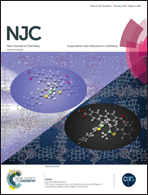An ultrasensitive sandwich-type electrochemical immunosensor based on δ-MnO2 and palladium nanoparticles covered natural halloysite nanotubes for the detection of hepatitis B surface antigen†
Abstract
A sensitive sandwich-type electrochemical immunosensor for the quantitative detection of hepatitis B surface antigen (HBsAg) was proposed and the nanocomposite of palladium nanoparticles/δ-manganese dioxide/halloysite nanotubes (Pd/δ-MnO2/HNTs) was used as a novel signal amplification strategy. δ-MnO2 could absorb a large amount of palladium nanoparticles (Pd NPs) due to their advantages of large surface area, good adsorption capacity and environmentally friendly. The earth possesses abundant HNTs, which could deter the agglomeration of δ-MnO2 and preserve the advantages of δ-MnO2 once loaded on HNTs. With high electrical catalytic activity of Pd NPs and δ-MnO2, the Pd/δ-MnO2/HNT nanocomposite could improve the analytical signal and achieve high sensitivity. The electroplated gold nanoparticles (Au NPs) as the platform of the immunosensor could immobilize the primary antibodies tightly and enhance the electron transfer efficiently. Under the optimal conditions, the immunosensor exhibited an extremely low detection limit of 0.3 pg mL−1 and a wide linear range from 0.001 ng mL−1 to 20 ng mL−1 for HBsAg. Moreover, it revealed good selectivity, acceptable reproducibility and stability, and exhibited application potentiality in clinical diagnosis.


 Please wait while we load your content...
Please wait while we load your content...